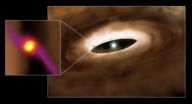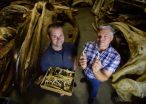(Press-News.org) A well-known biologist once theorized that many roads led to Rome when it comes to two distantly related organisms evolving a similar trait. A new paper, published in Nature Communications, suggests that when it comes to evolving some traits – especially simple ones – there may be a shared gene, one road, that's the source.
Jason Gallant, MSU zoologist and the paper's first author, focused on butterflies to illustrate his metaphorical roadmap on evolutionary traits. Butterfly wings are important biological models. While some butterflies are poisonous and notify their predators via colorful wing markings, others are nontoxic but have evolved similar color patterns to avoid being eaten.
Many scientists, including the famed Ernst Mayr, favored the "many roads" theory. This was largely attributed to being unable to identify a shared gene for such traits. Gallant, Sean Mullen, co-author and Boston University biologist, and their collaborators, however, were able to pinpoint the single gene responsible for two different families of butterflies' flashy markings.
The North American and South American species last had a common ancestor more than 65 million years ago. So, rather than evolve these traits independently using two unique mechanisms, the genetic control of particular butterfly markings can be traced to a single gene present in their ancient ancestors, said Gallant, who also teamed with Arnaud Martin and Bob Reed from Cornell University, and Marcus Kronforst from the University of Chicago.
"This result represents the culmination of a decade's worth of effort, but we identified the mechanism for a single aspect of wing patterns in a lineage," Gallant said. "Is this the rule or the exception? For simple traits, it's beginning to look like it could be the rule. The jury is still out on complicated traits, but there may be fewer roads leading to Rome than we once thought."
The decade-long journey began as a butterfly mapping study and later involved the 30,000 genes that comprise white admiral butterflies and red-spotted purple butterflies in North America. They are the same species of butterflies, but to a common observer, they look completely unrelated.
In the southern United States, the red-spotted purples have dark-blue wings that mimic the poisonous pipevine swallowtail. The white admirals, with distinctive white bands on their wings, reside in northern climes where the swallowtail is not found. A hybrid of the two can be found in a region near Pennsylvania.
Out of the 30,000 genes, Gallant, Mullen and their team narrowed the candidates to three. In one of these genes, WntA, they discovered the presence of a retrotransposon, a DNA virus of sorts, which appears to cause the deviations in wing pattern.
"It's the same type of DNA 'virus' that causes random-colored kernels in Indian corn," Gallant said. "It was present in 100 percent of the red-spotted purples, 50 percent of the hybrids and zero percent of the white admirals; I've never seen such clean data like this – ever."
For comparison, a different species of South American butterflies, studied by researchers from Cornell and the University of Chicago, were folded into the experiment. This species is separated by a mountain range rather than a continent, but the genetic patterns were the same. The group with dark wing markings had a deletion in the WntA gene in the same spot that the retrotransposon occurred in the North American butterflies.
When asked to comment on the significance of the work, Mullen stated the main goal of evolutionary biology is to understand the origin and maintenance of biodiversity. Within this context, a major unanswered question is whether or not evolution is predictable, and, if so, over what evolutionary time scales?
"We addressed this question by identifying the specific genetic changes responsible for the repeated evolution of similar color pattern traits in two butterfly lineages that last shared a common ancestor some 65 million years ago," he said. "Surprisingly, we found that changes in the expression of the same gene during development were responsible in both cases. This result implies an unprecedented level of predictability in the evolutionary process over deep time."
Since this evolutionary trait was triggered, perhaps somewhat accidentally, it stirs questions as to what other changes are taking place before our eyes.
"Copying errors and genomic viruses directly lead to the wing patterns of these beautiful butterflies," Gallant said. "It's these accidents that allow the evolutionary process to move forward. When I look over a field of butterflies, it makes me wonder what types of 'mistakes' are happening right now that may lead to important evolutionary changes years from now? What evolutionary processes will we someday be able to predict?"
INFORMATION: END
A single evolutionary road may lead to Rome
2014-09-08
ELSE PRESS RELEASES FROM THIS DATE:
New antimicrobial strategy silences NDM-1 resistance gene in pathogens
2014-09-08
Researchers have synthesized a molecule that can silence the gene responsible for severe antibiotic resistance in some bacteria. The research, presented at the 54th Interscience Conference on Antimicrobial Agents and Chemotherapy (ICAAC), an infectious disease meeting of the American Society for Microbiology (ASM) could be a viable new strategy for treating resistant infections.
The focus of this new molecule is NDM-1 (New Delhi metallo-beta-lactamase-1) a gene carried by some bacteria that allows them to produce an enzyme called carbapenemase.
"NDM-1 confers bacterial ...
Social networking can help people lose weight
2014-09-08
Social networking programmes designed to help people lose weight could play a role in the global fight against obesity, according to research.
Analysis by researchers from Imperial College London combining the results of 12 previous studies shows that such programmes have achieved modest but significant results in helping participants lose weight.
The paper is one of 10 reports on global healthcare policy written for the World Innovation Summit for Health (WISH), an initiative of Qatar Foundation, and published today in the journal Health Affairs.
Obesity is an increasing ...
Scientists take a look at the feel-good benefits of belly dance
2014-09-08
Belly dancers have fewer hang-ups about their bodies. Most women who participate in this torso-driven dance do so because it is fun and they get to perform interesting moves – not because they necessarily feel sexier while doing so. This is the conclusion of Marika Tiggemann of Flinders University in Australia, leader of a study in Springer's journal Sex Roles about the body image of people who belly dance in their free time.
Body image is the way in which someone perceives, feels and thinks about his or her body, especially factors regarding shape and weight. Previous ...
New research shows that there could be increased numbers of psychopaths in senior managerial positions and high levels of business
2014-09-08
A BREAKTHROUGH by a talented University of Huddersfield student has shown for the first time that people with psychopathic tendencies who have high IQs can mask their symptoms by manipulating tests designed to reveal their personalities. It raises the possibility that large numbers of ruthless risk-takers are able to conceal their level of psychopathy as they rise to key managerial posts.
Carolyn Bate, aged 22, was still an undergraduate when she carried out her groundbreaking research into the links between psychopathy and intelligence, using a range of special tests ...
NRL scientist explores birth of a planet
2014-09-08
Dr. John Carr, a scientist at the U.S. Naval Research Laboratory, is part of an international team that has discovered what they believe is evidence of a planet forming around a star about 335 light years from Earth. This research is published in the August 20th issue of The Astrophysical Journal.
Carr and the other research team members set out to study the protoplanetary disk around a star known as HD 100546, and as sometimes happens in scientific inquiry, it was by "chance" that they stumbled upon the formation of the planet orbiting this star. A protoplanetary disk, ...
Novel cancer drug proves safe for leukemia patients
2014-09-08
WINSTON-SALEM, N.C. – Sept. 8, 2014 – Results of a Phase I clinical trial showed that a new drug targeting mitochondrial function in human cancer cells was safe and showed some efficacy. The findings, reported by doctors at Wake Forest Baptist Medical Center, are published in the current online edition of the journal Clinical Cancer Research.
"This drug is selectively taken up by cancer cells and then shuts down the production of energy in the mitochondria," said Timothy Pardee, M.D., Ph.D., director of leukemia translational research at Wake Forest Baptist and principal ...
New genomic editing methods produce better disease models from patient-derived iPSCs
2014-09-08
New Rochelle, NY, September 8, 2014—Highly valuable for modeling human diseases and discovering novel drugs and cell-based therapies, induced pluripotent stem cells (iPSCs) are created by reprogramming an adult cell from a patient to obtain patient-specific stem cells. Due to genetic variation, however, iPSCs may differ from a patient's diseased cells, and researchers are now applying new and emerging genomic editing tools to human disease modeling, as described in a comprehensive Review article published in Stem Cells and Development, a peer-reviewed journal from Mary ...
Living in the shadow of Mauna Loa: A silent summit belies a volcano's forgotten fury
2014-09-08
Alexandria, Va. — Earth's largest active volcano, Mauna Loa on Hawaii's Big Island, is taking a nap. And after 30 years, no one is sure when the sleeping giant will awaken. Scientists say it's likely to erupt again within the next couple of decades and, when it does, it will be spectacular — and potentially dangerous.
Although Mauna Loa often takes a back seat to the more famous Kilauea, which has been erupting nearly continuously since 1983, history warns us that Mauna Loa's current silence is anomalous. Meanwhile, more people and more buildings pack into potentially ...
Whale sex: It's all in the hips
2014-09-08
Both whales and dolphins have pelvic (hip) bones, evolutionary remnants from when their ancestors walked on land more than 40 million years ago. Common wisdom has long held that those bones are simply vestigial, slowly withering away like tailbones on humans.
New research from USC and the Natural History Museum of Los Angeles County (NHM) flies directly in the face of that assumption, finding that not only do those pelvic bones serve a purpose – but their size and possibly shape are influenced by the forces of sexual selection.
"Everyone's always assumed that if you ...
Study puts some mussels into Bay restoration
2014-09-08
Restoring oysters—and their ability to filter large volumes of water—is widely seen as a key way to improve the health of Chesapeake Bay. New research makes this calculus even more appealing, showing that the mussels that typically colonize the nooks and crannies of a restored oyster reef can more than double its overall filtration capacity.
The study—by researchers at the University of Maryland, the Smithsonian Environmental Research Center, and the Virginia Institute of Marine Science—appears as the cover story in the most recent issue of Restoration Ecology.
"Many ...




